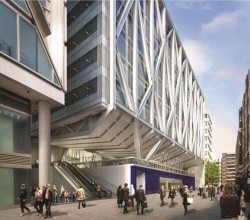"The greatest threat to our planet is the belief that someone else will save it." These are the profound words of adventurer and environmentalist Robert Swan who became the first person in history to walk both the North and South Poles.
Robert dedicates his life to protecting the Antarctic and our planet. He is brave and ambitious in fighting for the best future for us and our environment.
These attributes of an explorer resonate strongly with me. As an industry, we have a responsibility to ensure that both what and how we build has a positive impact on the world around us. As pressures on our planet persist, we too must become explorers and find new routes that lead to better, more sustainable places.
From their initial concept, buildings must be designed for ultimate performance but with minimal environmental impact. That means setting bold targets as an industry so we have something to aspire to. That's why we've joined forces with six other leading property developers - Great Portland Estates, Grosvenor Britain & Ireland, LGIM Real Assets, Lendlease, TH Real Estate and The Crown Estate - through the recently launched 'Design for Performance' approach, which sets challenging targets for energy use in both existing and future developments.
Robert is right that we can't wait for someone else to save our planet. In property, collaboration at all stages of the development lifecycle is essential if our work is to truly stand the test of time. Not all the answers lie within our industry, so it's important we also look outside our sector for ideas and inspiration.
One way we're innovating in our approach to development is how we choose the right construction partners. Our latest City development at 21 Moorfields is a hugely challenging project that involves building over a live tube station and a Crossrail ticket hall. To tackle it head on, we knew we needed a relationship built on partnership and full of ambition so, for the first time, we asked our potential construction partners to take part in behavioural assessments. We invited them to workshops where project teams were not only interviewed but also observed and assessed on collaborative working, communication and problem-solving skills. Appointing a contractor that you have already rehearsed challenges with means you can work more efficiently on site. It's not just our buildings that need to be sustainable; our relationships must be too.
Landsec's 21 Moorfields - an example of sustainable collaborative relationships in action
Those sustainable, collaborative relationships need to run through the entire supply chain. Working together has enabled us to explore new, innovative methods of construction. We can also make greater use of technology. Building information modelling (BIM), for example, allows us to build digitally and explore the intricacies of a development before the construction teams even arrive on site. Offsite construction methods are another area that is moving forward quickly and we're excited about both the time and waste reduction that these could bring.
Exploring new and unfamiliar territories can be challenging - and it certainly can't be done alone. But, like Robert, we need to keep pushing ourselves to strive above and beyond what we're comfortable with. We need to come together with our peers, our colleagues and our communities to be curious and keep exploring so, together, we can find the best possible solutions to build better and smarter for the future.









